3.1.3. Transport in plants
1/157
There's no tags or description
Looks like no tags are added yet.
Name | Mastery | Learn | Test | Matching | Spaced |
|---|
No study sessions yet.
158 Terms
why do plants need a transport system
large plants have a small SA:volume- diffusion too slow for movement of substances throughout the plant
metabolic demands of tissues that don’t photosynthesise
plants can grow to very tall
what is water transported through the plant in and which way
through the xylem, one direction- upwards
how does water enter the roots
osmosis through root hairs on root hair cells
how do minerals enter the plant
taken up by active transport by root hairs on root hair cells, decreases the water potential to draw more water in
what does the xylem carry
water and minerals
where does sugar come from in plants
made by photosynthesis in the leaves or stored in roots as starch
what does the phloem carry
assimilates, mainly sugar in the form of sucrose
which direction does the phloem transport sugars
both directions
what is the transport sugar in plants and why
sucrose- less reactive than glucose
how does the transport system in plants compare to animals and why
much slower transport system for their sugar as less metabolically active
what are the gases needed in plants
CO2 for photosynthesis and O2 for aerobic respiration
how do the gases needed (CO2 and O2) enter the plant
rely on diffusion, don’t use a transport system
what are the large gas exchange surfaces in plants
spongy mesophyll cells in leaves, root hair cells
define transpiration stream
the uninterrupted flow of water taken up by the roots, through the xylem and out of the stomata in the leaves due to the pull of transpiration
define transpiration
the loss of water vapour from aerial parts of a plant mainly through stomata
what is the summary of movement of water through plants
transpiration from leaves, movement of water across leaf cells, movement of water through xylem, movement of water across root cells, uptake from soil into root hair cells
what does transpiration rely on
the water potential gradient between the substomatal airspace and the atmosphere
what are the factors that effect rate of transpiration
temperature, wind speed, humidity and light intensity
what does the graph for the effect of temperature on rate of transpiration look like
increasing and then a hump and decreases a bit
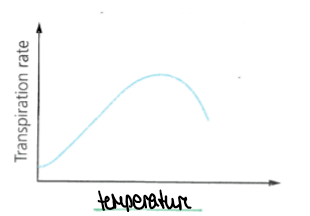
how does temperature effect rate of transpiration
as temperature increases kinetic energy of water molecules at stomatal opening increases, increases rate of movement of water vapour away from stomata, increases water potential gradient, increases rate of transpiration, at high temperature stomata close so rate of transpiration reduces
what does the graph for the effect of wind speed on rate of transpiration look like
increasing and then plateaus
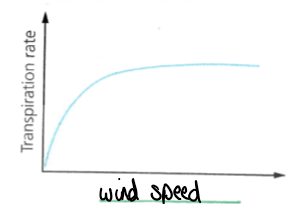
how does wind speed effect the rate of transpiration
air current moves water molecules away from stomatal opening, reduces water potential in air surrounding stomata, increases water potential gradient, increases rate of transpiration, when all stomata are open a plateau is reached (massively increased wind may cause stomata to close so the rate of transpiration may decrease)
what does the graph for the effect of humidity on rate of transpiration look like
linear and decreasing

how does humidity effect rate of transpiration
increasing humidity surrounding stomata increases water potential of air outside, decreases water potential gradient, decreases rate of transpiration
what is the effect of light intensity on rate of transpiration
stomata close in the dark, as light intensity increases, stomata opening increases, rate of transpiration increases, when all stomata are open, light intensity has no further effect on rate of transpiration
define stomatal density
the number of stomata in a unit area
how do you find the stomatal density on a leaf
take an epidermal impression by coating an area of the lower leaf surface with a thin layer of nail varnish
wait until it dries and then peel it off using Sellotape
stick Sellotape on a slide
count number of stomata in field of view
repeat 3 times for different parts of epidermis, calculate mean
use stage micrometre to calculate area of field of view
what is the name of broad leaved plants
dicotyledon leaves
what are dicotyledons
broad leaved plants
what sort of structure is a leaf
an organ
what is the name of the flat parts of the leaf either side of the central vein
lamina/blade
what is the name of the middle stem of a leaf
central vein
what is the name of the parts in a leaf that come off the central vein
lateral veins
what is the name of the bit that attaches a leaf to the stem
petiole
what make up the phloem
sieve tube elements, companion cells
what is the name for the xylem and phloem
vascular bundle
what is the name for the pockets of air around the spongy mesophyll cells
substomatal air space
what cells surround the substomatal air spaces
spongy mesophyll cells
how does transpiration occur
when the water potential of the atmosphere is less than the water potential of the sub-stomatal airspace, water molecules diffuse out when the stomata are open
when does movement of water vapour in the substomatal air space occur
when the water potential of the sub-stomatal airspace is less than the water potential of the cell walls of the spongy mesophyll cells: water vapour evaporates from the walls of the spongy mesophyll cells and diffuses down the water potential gradient into the sub-stomatal airspace
what are the routes for water across leaf cells called
the apoplast pathway, the symplast pathway
how does the apoplast pathway work with the structures of the cell wall
through the cell walls and extracellular space
cellulose microfibrils of the cell wall have channels between them through which water can flow easily
how does the apoplast pathway work for the movement of water across a leaf
as water evaporates from the cell walls into the substomatal airspace from one cell, it creates a tension which pulls water from spaces in the walls of adjacent cells, this pull occurs because of cohesive forces between the water molecules due to hydrogen bonds
which pathway is more common for water movement and why
apoplast pathway- 90%, it is the path of least resistance
what is the method of movement in the apoplast pathway
cohesion tension
how does the symplast pathway work
water moves through the cytoplasm’s of adjacent cells connected by plasmodesmata
why does less water travel through the symplast pathway
there is resistance to flow due to the presence of organelles
what is the process of movement in the symplast pathway for the movement of water across a leaf
cytoplasm of one cell loses water to the sub-stomatal airspace
the water potential of the cell becomes lower
the cell pulls in more water from its neighbour with a higher water potential
the water potential of this cell becomes lower
the process is repeated for cells across the leaf in the direction of the xylem to the stomata
a water potential gradient is established
what is the method of movement for the symplast pathway
water potential gradient
in a leaf cross-section is the xylem or phloem on top
xylem is above phloem (xp)
where is the xylem found in the stem
within the vascular tissue
what structures are in a vascular bundle in the stem
xylem, cambium, phloem, sclerenchyma
in the stem what is the structure of the vascular bundle
xylem on inside, then cambium, then phloem, then sclerenchyma
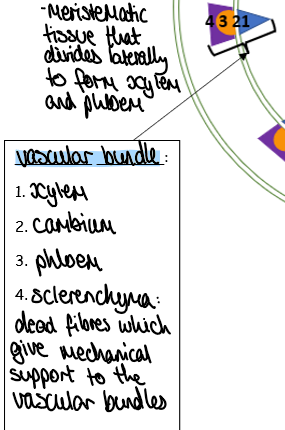
what is sclerenchyma
dead fibres which give mechanical support to the vascular bundles
what are the dead fibres which give mechanical support to the vascular bundles called
sclerenchyma
what is cambium
meristematic tissue that divides laterally to form the xylem and phloem
what is meristematic tissue that divides laterally to form the xylem and phloem called
cambium
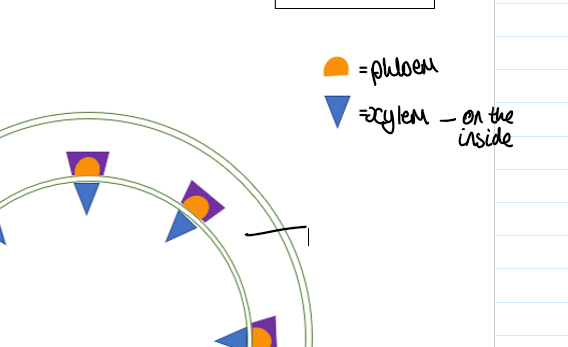
what is the outer layer in the cross-section of a stem called
cortex
what is the cortex
outer layer of the stem, made from collenchyma cells, have thickened cellulose cell walls

what is the inner layer in the cross-section of the stem called
pith
what is the pith
inside layer in the stem, made from parenchyma cells- unspecialised packing tissue
what packs around xylem vessels in the stem
parenchyma cells- unspecialised packing tissue (forms the pith)
how can xylem vessels be identified
thickened walls, no cell content, large lumen
in an image how can you identify companion cells from sieve tube elements
companion cells are darker
what is the structure of the xylem
xylem tissue is made of vessels packed between parenchyma cells
dead cells lined end to end whose horizontal walls have been broken down
lined with rings/spirals of lignin
large bordered pits on the side of some vessels to allow sideways movement of water for living cells in the stem
why have the horizontal walls in xylem been broken down
so water can travel in a continuous uninterrupted column
what is the function of lignin in the xylem
give mechanical strength to the vessel, allow flexibility of movement, keep the vessels open and stops them collapsing especially when the transpiration pull exert negative pressure on the walls
what are the mechanisms of movement of water in xylem
cohesion tension, adhesion- capillarity, root pressure
how does cohesion tension allow for movement of water in the xylem
as water molecules move up the xylem they attract neighbouring water molecules by cohesion tension due to intermolecular hydrogen bonds between the polar water molecules, water is pulled up huge heights due to the collectively strong cohesive forces giving rise to a negative hydrostatic pressure in the xylem vessels
what is evidence for the cohesion tension theory of the mechanism of movement of water up the xylem
changes in diameter of trees- during the day negative pressure in xylem vessels causes tension and narrowing of the vessels and shrinkage of the trunk diameter, at night water remains in the trunk when transpiration is low, tension is low and the trunk swells
how does adhesion- capillarity allow for the movement of water up the xylem
water molecules are attracted to the walls of the xylem vessels due to adhesive forces, this however can create a frictional drag
how does root pressure allow for the movement of water up the xylem
minerals are pumped into the xylem tissue at the roots by active transport using ATP, this lowers the water potential of the xylem at the roots, water diffuses in due to the water potential gradient, this is called root pressure, it facilitates the movement of water into the roots from the soil
what evidence is there for root pressure causing movement of water up the xylem
presence of starch grains in cells adjacent to the xylem in the roots, experiments using exudation
how does the presence of starch grains in cells adjacent to the xylem in the roots support root pressure theory
the starch is hydrolysed to glucose which is used for aerobic respiration which provides the ATP for the active transport of the minerals pumped into the xylem
how do experiments using exudation (water appearing at the top of a cut stem when roots are intact) support root pressure theory when there is no oxygen
no aerobic respiration so no ATP for the active transport of the minerals pumped into the xylem
how do experiments using exudation (water appearing at the top of a cut stem when roots are intact) support root pressure theory when there is a low temperature
rate of reaction for ATP production lowered, no ATP for the active transport of the minerals pumped into the xylem
how do experiments using exudation (water appearing at the top of a cut stem when roots are intact) support root pressure theory when there is a metabolic poison introduced
affect mitochondria, stops aerobic respiration, no ATP produced for the active transport of the minerals pumped into the xylem
what are the different experiments using exudation used to provide evidence to support root pressure
no oxygen, low temperature, metabolic poison
what is the general structure of the xylem and phloem in the roots
xylem in a cross with phloem in the gaps
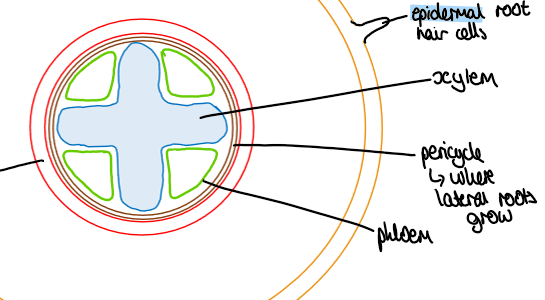
what are the tissue layers in the root
epidermis, cortex, endodermis, pericycle, xylem

what is the name for the hairs on the root cells
epidermal root hair cells
what is the pericycle
tissue layer in the root, between endodermis and xylem, where lateral root grow
where do lateral roots grow from
the pericycle
what are the pathways for water across root cells called
apoplast pathway and symplast pathway
how does the apoplast pathway help the movement of water in the root
through the cell walls and intercellular space, movement through cell wall is prevented at the Casparian strip in the cell wall of the endodermis, forces the passage of the water into the endodermal cells to join the symplast pathway
what forces the water to leave the apoplast pathway in the roots
the Casparian strip
what is the Casparian strip made of
suberin- very impermeable to water
what is the purpose of the Casparian strip
endodermal cells check for entry of pathogens through selectively permeable cell surface membrane, help bring about plant defences
how does the symplast pathway help the movement of water in the roots
moves through the cytoplasm of adjacent cells connected by plasmodesmata, water travels down its water potential gradient: soil to epidermis to cortex to endodermis to pericycle to xylem
how does the uptake of water by root hair cells happen
the water potential of the soil is greater than the water potential of the root hair cells, water is absorbed by osmosis down the water potential gradient, water also enters the apoplast pathway
how are root hairs adapted as exchange surfaces
microscopic size so can penetrate between soil particles and ensure constant contact with water
large SA:volume
thin cellulose cell walls for rapid diffusion and osmosis
concentration of solute in the cytoplasm maintains water potential gradient between soil water and cell
many mitochondria for active transport of ions
what are different types of plant in relation to water availability
mesophyte, xerophyte, hydrophyte, halophyte
what is a mesophyte
plants adapted to a habitat with adequate availability of water
what is a xerophyte
plants adapted to a habitat with low availability of water
what is a hydrophyte
plants adapted to a habitat with plentiful freshwater
what is a halophyte
plants adapted to a habitat with saline water
what are plants adapted to a habitat with saline water called
halophyte
what are plants adapted to a habitat with adequate availability of water called
mesophyte
what are examples of xerophytes
marram grass, cacti
what are features of marram grass
hinge cells cause leaf to roll up, upper epidermis is inside the leaf, sunken stomata, hairs, thick cuticle on lower epidermis